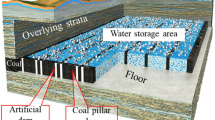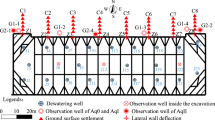Abstract
The hydrodynamic changes and ground settlement induced by engineering dewatering have received much attention, and leakage between different aquifers is often neglected. Obviously, the leakage strength is crucial for the safety of underground engineering in soluble rock distribution areas. In this paper, we examined the Tianfu New Area in Chengdu, China, which contains a paste salt formation, based on numerical simulation techniques, characteristics of hydrodynamic field, leakage strength and ground settlement changes under different combinations of pumping well filter length and waterproof curtain depth were investigated. In the process of optimizing the dewatering scheme for this area, the leakage strength was innovatively included in the evaluation index. We found that as the depth of waterproof curtain increases, the trend of ground settlement and leakage strength caused by dewatering can be divided into a rapid decline phase and a gradual decline phase. However, the critical curtain depths of the two stages of ground settlement and leakage strength are different. The optimization scheme for dewatering engineering was determined under hydrodynamic, leakage strength, and ground settlement constraints. The filter length of the corresponding optimization scheme was 12 m, and the suitable depth of the waterproof curtain was 14–16 m. Our results provide an effective solution and method for optimizing the dewatering scheme in underground engineering projects with gypsum-bearing strata.
















Similar content being viewed by others
Data availability
Data will be made available on request.
References
Anderson EI, Mesa E (2006) The effects of vertical barrier walls on the hydraulic control of contaminated groundwater. Adv Water Resour 29:89–98
Barton A, Wilde N (1971) Dissolution rates of polycrystalline samples of gypsum and orthorhombic forms of calcium sulphate by a rotating disc method. Trans Faraday Soc 67:3590–3597
Bruce D, Paoli BD, Mascardi C, Mongilardi E (1989) Monitoring and quality control of a 100 meter deep diaphragm wall
Butscher C (2015) Hydrogeological controls on the swelling of clay-sulfate rocks in tunneling. Springer International Publishing
Butscher C, Huggenberger P, Zechner E (2010) Impact of tunneling on regional groundwater flow and implications for swelling of clay–sulfate rocks. Eng Geol 117:198–206
Butscher C, Einstein HH, Huggenberger P (2011) Effects of tunneling on groundwater flow and swelling of clay-sulfate rocks. Water Resour Res 47:11520
Chen Z, Huang J, Zhan H, Wang J, Dou Z, Zhang C, Chen C, Fu Y (2022) Optimization schemes for deep foundation pit dewatering under complicated hydrogeological conditions using MODFLOW-USG. Eng Geol 303:106653
Finno RJ, Blackburn JT, Roboski JF (2007) Three-dimensional effects for supported excavations in clay. J Geotech Geoenviron Eng 133:30–36
Jaeger JC, Cook N (1979) Fundamentals of rock mechanics, 3rd edn. Science Paperbacks, pp 251–252
Klimchouk A, Andrejchuk V (2002) Karst breakdown mechanisms from observations in the gypsum caves of the western ukraine: implications for subsidence hazard assessment. Int J Speleol. https://doi.org/10.5038/1827-806X.31.1.4
Lei H, Xu T, Jin G (2015) Tough2biot – a simulator for coupled thermal–hydrodynamic–mechanical processes in subsurface flow systems: application to CO2 geological storage and geothermal development—ScienceDirect. Comput Geosci 77:8–19
Li C, Hu Y, Meng T, Zhang C, Hu Y (2020) Mode-i fracture toughness and mechanisms of salt-rock gypsum interlayers under real-time high-temperature conditions. Eng Fract Mech 240:107357
Li D, Ma J, Wang C, Gao X, Fang M (2022) A new method for piping risk evaluation on unconfined aquifers under dewatering of deep foundation pits. KSCE J Civ Eng 26:3275–3286
Ni JC, Cheng WC, Ge L (2013) A simple data reduction method for pumping tests with tidal, partial penetration, and storage effects. Soils Found 53:894–902
Pando L, Pulgar JA, Gutierrez-Claverol M (2013) A case of man-induced ground subsidence and building settlement related to karstified gypsum (Oviedo, NW Spain). Environ Earth Sci 68:507–519
Pruess K, Oldenburg CM, Moridis GJ (1999) Tough2 user’s guide version 2. Office of Scientific & Technical Information Technical Reports
Raines MA, Dewers TA (1997) Mixed transport/reaction control of gypsum dissolution kinetics in aqueous solutions and initiation of gypsum karst. Chem Geol 140:29–48
Shang J, Wang S, Wang C, Song C (2010) Mensuration of microstructure multi-fractal spectra of calcined limestone particle surfaces. Parricuology. https://doi.org/10.1016/j.partic.2010.07.004
Shen SL (2011) Numerical evaluation of land subsidence induced by groundwater pumping in Shanghai. Can Geotech J 48:1378–1392
Shen SL, Jie H, Du YJ (2008) Deep mixing induced property changes in surrounding sensitive marine clays. J Geotech Geoenviron Eng 134:845–854
Shen SL, Wu YX, Misra A (2017) Calculation of head difference at two sides of a cut-off barrier during excavation dewatering. Comput Geotech 91:192–202
Tan Y, Lu Y (2017) Why excavation of a small air shaft caused excessively large displacements: forensic investigation. J Perform Constr Facil 31:04016083
Wang CB, Ding WQ (2011) Monitoring and analysis of pore water pressure outside of diaphragm wall of super-deep foundation pit. J Lanzhou Univ Technol (In Chinese)
Wang J, Liu X, Wu Y, Liu S, Wu L, Lou R, Lu J, Yin Y (2017) Field experiment and numerical simulation of coupling non-darcy flow caused by curtain and pumping well in foundation pit dewatering. J Hydrol 549:277–293
Wang J, Liu X, Liu S, Zhu Y, Pan W, Zhou J (2018) Physical model test of transparent soil on coupling effect of cut-off wall and pumping wells during foundation pit dewatering. Acta Geotech. https://doi.org/10.1007/s11440-018-0649-2
Wang J, Deng Y, Wang X, Liu X, Zhou N (2022) Numerical evaluation of a 70-m deep hydropower station foundation pit dewatering. Environ Earth Sci 81:364
Wang J, Long Y, Zhao Y, Pan W, Qu J, Yang T, Huang X, Liu X, Xu N (2023) Numerical simulation of forming MICP horizontal seepage reducing body in confined aquifer for deep excavation. Appl Sci 13:601
Wu Q, Liu Y, Luo L, Liu S, Sun W, Zeng Y (2015) Quantitative evaluation and prediction of water inrush vulnerability from aquifers overlying coal seams in Donghuantuo Coal Mine, China. Environ Earth Sci 74:1429–1437
Wu YX, Shen SL, Yuan DJ (2016) Characteristics of dewatering induced drawdown curve under blocking effect of retaining wall in aquifer. J Hydrol 539:554–566
Wu YX, Lyu HM, Shen JS, Arulrajah A (2018) Geological and hydrogeological environment in Tianjin with potential geohazards and groundwater control during excavation. Environ Earth Sci 77:392
Xu YS, Shen SL, Ma L, Sun WJ, Yin ZY (2014) Evaluation of the blocking effect of retaining walls on groundwater seepage in aquifers with different insertion depths. Eng Geol 183:254–264
Xu Y-S, Wu H-N, Wang BZ-F, Yang T-L (2017a) Dewatering induced subsidence during excavation in a Shanghai soft deposit. Environ Earth Sci 76:1–15
Xu YS, Wu HN, Shen JS, Zhang N (2017b) Risk and impacts on the environment of free-phase biogas in quaternary deposits along the coastal region of Shanghai. Ocean Eng 137:129–137
Yang Q, Chen S, Yuan Y (2023) Experimental study on the variation rule of water level outside the pit caused by dewatering in the pit and the rule of reinjection outside the pit. Front Mater 10:1192557
Ye-Shuang Xu, Shui-Long S, Yan-Jun Du (2009) Geological and hydrogeological environment in Shanghai with geohazards to construction and maintenance of infrastructures. Eng Geol 109:241–254
Zeng CF, Wang S, Xue X-L, Zheng G, Mei G-X (2022) Characteristics of ground settlement due to combined actions of groundwater drawdown and enclosure wall movement. Acta Geotech 17:4095–4112
Zhou W, Liao S (2016) The analysis and control of inrush and mud gushing in the broken rock tunnel under high water pressure. Procedia Eng 165:259–264
Acknowledgements
This study was supported by the Chengdu Multi-factor City Geological Survey (DD20189210) and Comprehensive Geological Survey of Resources and Environment in the Cheng-Mian-Le Development Zone of the Shuangcheng Economic Circle in the Chengdu-Chongqing Area (DD20211402).
Author information
Authors and Affiliations
Contributions
SP: investigation, numerical simulation, writing-original draft. FW: project administration, supervision, writing—review and editing. DW: data validation. SL: investigation. YY: simulation scheme guidance. MW: investigation. HP: investigation. YC: project administration. All authors reviewed the manuscript.
Corresponding author
Ethics declarations
Conflict of interest
The authors declared that they have no conflicts of interest to this work. We declare that we do not have any commercial or associative interest that represents a conflict of interest in connection with the work submitted.
Additional information
Publisher's Note
Springer Nature remains neutral with regard to jurisdictional claims in published maps and institutional affiliations.
Rights and permissions
Springer Nature or its licensor (e.g. a society or other partner) holds exclusive rights to this article under a publishing agreement with the author(s) or other rightsholder(s); author self-archiving of the accepted manuscript version of this article is solely governed by the terms of such publishing agreement and applicable law.
About this article
Cite this article
Ping, S., Wang, F., Wang, D. et al. Optimization of a deep foundation pit dewatering scheme in gypsum-bearing strata. Environ Earth Sci 83, 8 (2024). https://doi.org/10.1007/s12665-023-11310-6
Received:
Accepted:
Published:
DOI: https://doi.org/10.1007/s12665-023-11310-6




